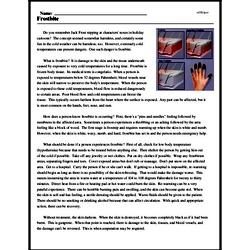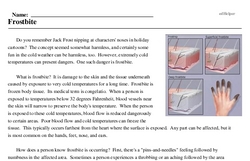Frostbite
Do you remember Jack Frost nipping at characters' noses in holiday cartoons? The concept seemed somewhat harmless, and certainly some fun in the cold weather can be harmless, too. However, extremely cold temperatures can present dangers. One such danger is frostbite.
What is frostbite? It is damage to the skin and the tissue underneath caused by exposure to very cold temperatures for a long time. Frostbite is frozen body tissue. Its medical term is congelatio. When a person is exposed to temperatures below 32 degrees Fahrenheit, blood vessels near the skin will narrow to preserve the body's temperature. When the person is exposed to these cold temperatures, blood flow is reduced dangerously to certain areas. Poor blood flow and cold temperatures can freeze the tissue. This typically occurs farthest from the heart where the surface is exposed. Any part can be affected, but it is most common on the hands, feet, nose, and ears.
How does a person know frostbite is occurring? First, there's a "pins-and-needles" feeling followed by numbness in the affected area. Sometimes a person experiences a throbbing or an aching followed by the area feeling like a block of wood. The first stage is frostnip and requires warming up when the skin is white and numb. However, when the skin is white, waxy, numb, and hard, frostbite has set in and the person needs emergency help.




